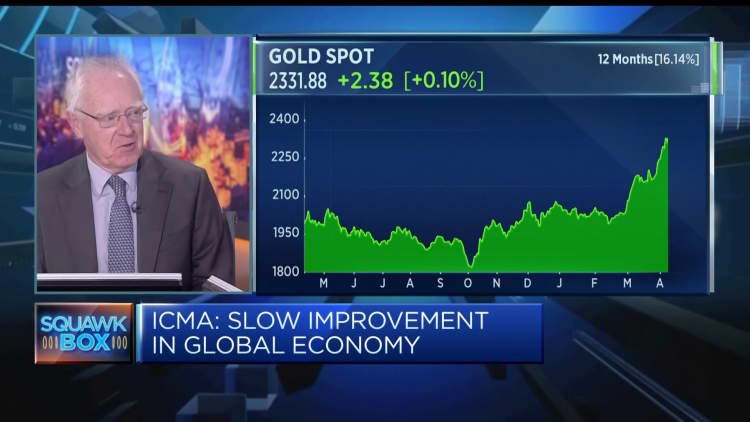
Gold prices on Monday extended their record-breaking run, notching another all-time high amid robust U.S. economic data and elevated geopolitical tensions.
Spot gold prices rose 0.5% to trade at $2,342 per ounce at around 11:45 a.m. London time, after briefly hitting a fresh record of $2,353 earlier in the session. The yellow metal has repeatedly logged all-time highs in recent weeks.
For some on Wall Street, strength in the price of gold is expected to continue until at least the second half of the year. Citi has previously described the asset as a developed market “recession hedge,” while others have suggested that volatility from the ongoing wars in Ukraine and the Gaza Strip could provide further support.
But not everyone is convinced gold prices will continue to rally.
“I think there are two factors,” Bob Parker, senior advisor at trade body International Capital Markets Association, told CNBC’s “Squawk Box Europe” on Monday.
“Factor number one is what I call the catch-up effect, whereby, if you look at actually the ratio of gold relative to global equity markets last year and the beginning of this year, gold massively underperformed.”
“So, there is that catch-up effect. Investors are looking at the underperformance of gold and therefore increasing exposure to gold. Related to that is actually the gold-bitcoin correlation — and one can get into a debate about whether that’s meaningful or not — but the reality is there is a correlation between bitcoin and gold,” Parker said.
“The other factor, where it’s very difficult to get hold of data, is, I do think there has been some central bank buying, particularly from Asian central banks, increasing their asset allocation in their reserves to gold.”
An employee handles one kilogram gold bullions at the YLG Bullion International Co. headquarters in Bangkok, Thailand, on Friday, Dec. 22, 2023.
Chalinee Thirasupa | Bloomberg | Getty Images
Gold, which is typically considered a “safe haven” asset at times of financial uncertainty, has rallied despite high interest rates and a relatively strong U.S. dollar.
Looking ahead, Parker said the fundamentals for gold appeared to paint a bearish picture, citing U.S. dollar strength, rising bond yields, doubts creeping in over the Federal Reserve’s rate cutting plans and “reasonably” low inflation.
“All of those factors actually suggest that upside in gold, frankly, is minimal and I think gold is now very vulnerable to a setback,” Parker said.
Market participants have been closely monitoring comments from Fed officials about the expected number of rate reductions likely to take place this year.
In line with expectations, the U.S. central bank last month held interest rates steady for a fifth consecutive meeting, keeping its benchmark overnight borrowing rate at 5.25%-5.5%. The Fed also signaled that it still expects three quarter-percentage point cuts by the end of 2024.
Fed officials have since raised the prospect of zero rate cuts if inflation remains sticky, and job creation in March comfortably topped expectations, potentially delaying the anticipated Fed rate cuts of this year.
Silver to outshine gold?
“We have been very bullish on precious metals for a while so obviously that’s great but even we are a little bit puzzled as to the strength of gold,” Edmund Shing, chief investment officer at BNP Paribas Wealth Management, told CNBC’s “Street Signs Europe” on Monday.
“What is interesting about gold, and I think very encouraging for the medium term, is that the momentum for gold has completely broken away from its traditional correlation to real interest rates and to the U.S. dollar.”
Shing said that gold seemed to be getting a bit of a lift from investors “looking much further ahead” to issues such as debt sustainability. Like Parker, Shing also highlighted the role of central bank demand in boosting gold prices.

“Let’s not forget, central banks around the world, notably of course [those of ] China, India, [and] emerging market central banks, have been accumulating gold quite steadily,” Shing said.
“What may be more even exciting right now is the reaction we’re seeing in other precious metals, notably silver, which is finally starting to catch up. But it is still far, far away from its $50 an ounce all-time high reached all the way back in 2011,” he added.
Gold and silver prices have traditionally shown a strong positive correlation, although silver has sometimes been described as the “poorer cousin” of gold.
Analysts have previously told CNBC that silver appears well placed to outshine gold in the second half of the year.

